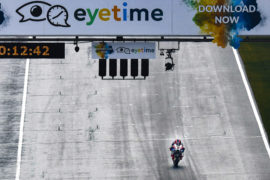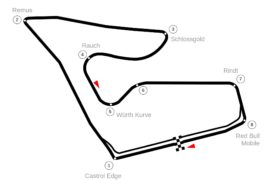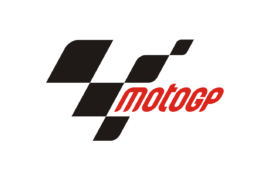Does the absence of Valentino Rossi from the Misano race make much difference? It is too early to tell. Certainly the media center feels a little more empty, but this is a trend which has been underway for a while.
Print media has less money to spend, and non-specialist media is increasingly choosing not to report from the race track, taking their information from publicly available sources such as the ever-expanding TV coverage.
Specialist print media and websites are also suffering, though their very rationale depends on being at the track, and so they have little choice.
So maybe a more empty press room is a sign that Italian newspapers have decided against sending a correspondent because Valentino Rossi is not racing. Alternatively, it could just be a sign of a more general decline in media presence.
The paddock feels pretty busy, but then it was only Thursday, and the real frenzy doesn’t start until the bikes hit the track. We won’t really know how badly Rossi absence affects the Misano race until the flag drops on Sunday, and official figures and empty spots on grandstands tell the true tale.
Changing Championship Approach?
A more immediate consequence of Rossi’s absence is a possible effect on the championship. The top three – Andrea Dovizioso, Marc Márquez, and Maverick Viñales – are separated by just 13 points.
Rossi is fourth, 26 points behind Dovizioso, while Dani Pedrosa sits in fifth with a deficit of 35 points. With Rossi out of the equation, championship strategy could change.
The top three in the championship disagreed with that proposition on Thursday afternoon. “We don’t change anything, because we are still a lot of riders fighting for the championship,” Andrea Dovizioso said. “There are still six races and anything can happen. There are a lot of points left, and everybody has to take the maximum every race.”
“This championship it’s important to not make a zero, but when you are able to win the race like I did in the last two races, you have to get it. Because sometimes it can happen that you are not competitive and you can lose a lot of points.”
Marc Márquez agreed. “Like Dovi says, nothing changes,” the Repsol Honda rider told the press conference. “We are a lot of riders at the front with important possibilities to win the title, so you must push at 100%, and everything can change.”
“I was able to open a small gap, I was able to feel really good on the bike, and at Silverstone, something happened that I didn’t expect, and again I’m behind. But anyway, there are still six races, many points, so just push at 100% every Sunday.”
“The approach of the championship is the same,” Maverick Viñales added to the chorus of unanimity. “At the end, we are three, four riders very close, so every race you have to give 100% and trying to be at the front, so the approach is completely the same. Trying to be on a good level.”
No Ethos for Team Orders
Any suggestion that teammates should be thinking about helping out championship contenders was dismissed on much the same grounds.
When I asked Jorge Lorenzo what he would do in the hypothetical situation that he was leading the race on the last lap, just ahead of Andrea Dovizioso, whether he would pull over and give his teammate five extra points which could be crucial at the end of the season, or take the win, Lorenzo had no hesitation.
“I will win the race.” Though his first reaction was to greet the suggestion with a wry smile, and comment “Nice idea, no?” It is not a realistic scenario right now.
But with the improvement Lorenzo has shown, and the much better feeling the new aero package has created, the scenario is not as outlandish as it would have been 8 or 9 races ago.
Dovizioso himself was much more sanguine about the whole situation. “There still remain six races, and everybody has to try to make their own race,” the Italian responded when the same hypothetical situation was put to him.
“So for sure, everybody has to try to win the race, that’s his goal, and it’s normal like this.” It is, in short, far too early to be thinking about team orders.
Quick Return?
Rossi’s absence has also managed to sustain the feverish speculation over who might replace him. Katsuyuki Nakasuga is still the nominal favorite to step in at Aragon, but the debate has started to shift.
There are signs it may be another Yamaha rider, rather than the veteran Japanese test rider. It won’t be Alex Lowes, however, at least not if his brother Sam is to be believed. “He won’t race the MotoGP bike this year,” the Aprilia rider let slip during his media debrief.
There is a small but non-zero chance that Valentino Rossi’s replacement will actually be, well, Valentino Rossi. The Italian has been speaking to TV broadcasters, including Italian Sky and the official MotoGP.com website.
In those interviews, Rossi intimated that the break isn’t as bad as the last time he did this, at Mugello in 2010. He is already hard at work with physiotherapy, and doing physical rehab.
Rossi is certain he can be back for Motegi, but he has not yet written off the idea of trying to ride during FP1 at Aragon, in two weeks’ time. Motegi would be 43 days from when Rossi broke his leg. FP1 at Aragon would be just 22 days. Not probable. But not outright impossible either.
Yesterday, A GP15, Tomorrow a Panigale V4
With so many Italian companies active in the motorcycle industry, Misano is also the place which many choose to present new products and technologies. On Friday, Nolan will be launching a new helmet.
On Thursday, both Ducati and Aprilia held launches of their latest innovations. Ducati’s offering had been telegraphed well ahead of time: the V4 Stradale engine, which will power the next generation of Ducati’s Panigale superbikes (and yes, they will continue to be called Panigale, despite being a V4, rather than a V2).
But there are a few things worth noting. The most surprising is that the engine in the bike to be launched in November is 1103cc, well above the legal limit for WorldSBK entry.
The WorldSBK-legal 1000cc bike is to introduced at the end of 2018, ready for the 2019 season. Ducati test rider Michele Pirro will be jumping on one of the early versions of that bike later this year.
The Stradale V4, as the engine is being called, is an engine aimed purely at use in sports bikes. It is based on the Desmosedici GP15, and produces over 210hp. The firing interval is the same as the MotoGP bike, firing at 0°, 90°, 290°, and 380°, the two 90° cranks offset by 20°.
That firing interval is the best compromise between rideability and horsepower. Top speed was “closer to the MotoGP bike than the Panigale,” Michele Pirro hinted, as much as the scowls of the PR arm of Ducati would permit him to divulge.
A Literal Vision of the Future
As fascinating as the Stradale V4 presentation was – and anyone who wants to get a hint of the technology underlying Ducati’s MotoGP bike should have a browse around the dedicated Stradale website – it was neither as surprising nor as revolutionary as the presentation held in the Aprilia garage.
We went there expecting a glimpse of Aprilia’s updated aerodynamic fairing, but instead were treated to what looks like the beginning of a technological revolution in the garage.
There, Aprilia presented and demonstrated a new augmented reality helmet to be used by their mechanics in MotoGP. The concept is to have a helmet with a glass visor which acts as a heads up display.
The heads up display shows an overlay of data over the object the mechanic is looking at, to assist them in doing their jobs a lot faster.
The helmet has cameras fitted, including a thermal imaging camera. The cameras help identify what the mechanic is looking at, and can recognize each part on the bike based on a 3D model of the machine in the system’s memory.
Aprilia gave several useful examples: when a mechanic looks at a part on the bike, they can call up the mileage on that particular part.
The factory has mileage limits on every single component on the bike, aimed at optimizing the life of the part with its performance. So a mechanic can tell just by looking at a part whether it needs to be changed or not.
The thermal imaging camera can be used to help optimize cooling. Radiators and oil coolers are among the most vulnerable parts on the bike, with stones and track debris capable of damaging them and reducing their efficiency.
If a coolant channel is blocked, or dirt is clogging up the airways, the thermal camera can show that up immediately, and allow a mechanic to identify problems and fix them quickly.
Time and Communication, The Only Two Things that Count
Above all, the augmented reality helmets will vastly improve communication between the members of the crew.
A crew chief can instruct mechanics to get the bike ready with a particular tire combination and make specific changes to suspension settings or geometry while a session is underway, without having to worry about being drowned out by the fearsome shriek of 23 MotoGP bikes howling past on the front straight.
Instructions are clear and direct, and everyone is informed immediately.
This system, when it comes into use, will not see much use in a race. But in practice, and especially in qualifying, it will be absolutely vital. If a team can save a few seconds each time a rider comes into the pits, that can quickly add up to allow the rider to make an extra exit.
In qualifying, the difference between making one or two flying laps can literally be a matter of a second or two. Cross the line in time, get another lap. A second later, and the checkered flag is out, and you are too late.
With FP1 to FP3 crucial for direct passage through to Q2, and just 15 minutes of qualifying, every second counts. These helmets find teams valuable time they cannot get anywhere.
The system is a specific software platform developed by Italian company Realmore, built on top of a smart helmet built and developed by DAQRI.
Similar systems are already in use elsewhere, such as the offshore industry and aviation. In a data-rich environment where performance is at the heart of everything a team does, this is an obvious next step.
It was a day for glimpses of the future. When we returned to our desks after the presentation by Aprilia, we found a sheet of paper put there by the circuit, reminding us all kindly that the use of drones for photography or filming purposes is strictly banned. The times they are a-changin’.
Photo: Aprilia
This article was originally published on MotoMatters, and is republished here on Asphalt & Rubber with permission by the author.




